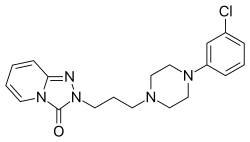Serotonin antagonist and reuptake inhibitor
Serotonin antagonist and reuptake inhibitors (SARIs) are a class of drugs used mainly as antidepressants, but also as anxiolytics and hypnotics. They act by antagonizing serotonin receptors such as 5-HT2A and inhibiting the reuptake of serotonin, norepinephrine, and/or dopamine. Additionally, most also antagonize α1-adrenergic receptors. The majority of the currently marketed SARIs belong to the phenylpiperazine class of compounds.

List of SARIs
Marketed
- Etoperidone (Axiomin, Etonin)
- Lorpiprazole (Normarex)
- Mepiprazole (Psigodal)
- Nefazodone (Serzone, Nefadar)
- Trazodone (Desyrel)
Miscellaneous
- Vilazodone (Viibryd) – a related drug but does not fit into this class as it does not function as a serotonin antagonist, acting solely as a 5-HT1A receptor partial agonist instead.
- Vortioxetine (Trintellix) – another closely related drug, could technically be considered to be a member of this group, but both vilazodone and vortioxetine are instead generally labeled as serotonin modulators and stimulators.
- Niaprazine (Nopron) – a drug related to this group but does not inhibit the reuptake of serotonin or the other monoamines.
- Medifoxamine (Clédial, Gerdaxyl) – could perhaps technically be said to belong to this group, as it is a serotonin–dopamine reuptake inhibitor and 5-HT2A and 5-HT2C receptor antagonist, but not grouped as such.[1]
Never marketed
- Lubazodone (YM-992, YM-35995) – a SARI that was never marketed.
Pharmacology
Binding profiles
The binding profiles of SARIs and some metabolites in terms of their affinities (Ki, nM) for various receptors and transporters are as follows:[2]
| Compound | SERT | NET | DAT | 5-HT1A | 5-HT2A | 5-HT2B | 5-HT2C | 5-HT3 | 5-HT6 | 5-HT7 | α1 | α2 | D2 | H1 | mACh | |
|---|---|---|---|---|---|---|---|---|---|---|---|---|---|---|---|---|
| Etoperidone | 890 | 20,000 | 52,000 | 85 | 36 | ND | ND | ND | ND | ND | 38 | 570 | 2,300 | 3,100 | >35,000 | |
| Hydroxynefazodone | 165–1,203 | 376–1,053 | ND | 56–589 | 7.2–34 | ND | ND | ND | ND | ND | 8.0–145 | 63–2,490 | ND | ND | 11,357 | |
| mCPP | 202–432 | 1,940–4,360 | ND | 44–400 | 32–398 | 3.2–63 | 3.4–251 | 427 | 1,748 | 163 | 97–2,900 | 106–570 | >10,000 | 326 | >10,000 | |
| Nefazodone | 200–459 | 360–618 | 360 | 80 | 26 | ND | 72 | ND | ND | ND | 5.5–48 | 84–640 | 910 | ≥370 | >10,000 | |
| Trazodone | 160–367 | ≥8,500 | ≥7,400 | 96–118 | 20–45 | 74–189 | 224–402 | >10,000 | >10,000 | 1,782 | 12–153 | 106–728 | ≥3,500 | 220–1,100 | >10,000 | |
| Triazoledione | ≥34,527 | >100,000 | ND | 636–1,371 | 159–211 | ND | ND | ND | ND | ND | 173 | 1,915 | ND | ND | >100,000 | |
| Values are Ki (nM). The smaller the value, the more strongly the drug binds to the site. For assay species and references, see the individual drug articles. Most but not all values are for human proteins. | ||||||||||||||||
These drugs act as antagonists or inverse agonists of the 5-HT2A, α1-adrenergic, and H1 receptors, as partial agonists of the 5-HT1A receptor,[3] and as inhibitors of the transporters. mCPP is an antagonist of the 5-HT2A and 5-HT2B receptors and an agonist of the 5-HT1A,[3] 5-HT2C, and 5-HT3 receptors.[4][5]
See also
References
- Gainsborough N, Nelson ML, Maskrey V, Swift CG, Jackson SH (1994). "The pharmacokinetics and pharmacodynamics of medifoxamine after oral administration in healthy elderly volunteers". Eur. J. Clin. Pharmacol. 46 (2): 163–6. doi:10.1007/bf00199882. PMID 8039537.
- Roth, BL; Driscol, J. "PDSP Ki Database". Psychoactive Drug Screening Program (PDSP). University of North Carolina at Chapel Hill and the United States National Institute of Mental Health. Retrieved 11 September 2017.
- Odagaki Y; Toyoshima R; Yamauchi T (May 2005). "Trazodone and its active metabolite m-chlorophenylpiperazine as partial agonists at 5-HT1A receptors assessed by [35S]GTPgammaS binding". Journal of Psychopharmacology (Oxford, England). 19 (3): 235–41. doi:10.1177/0269881105051526. PMID 15888508.
- Nelson DL, Lucaites VL, Wainscott DB, Glennon RA (1999). "Comparisons of hallucinogenic phenylisopropylamine binding affinities at cloned human 5-HT2A, -HT(2B) and 5-HT2C receptors". Naunyn Schmiedebergs Arch. Pharmacol. 359 (1): 1–6. doi:10.1007/pl00005315. PMID 9933142.
- Thomas DR, Gager TL, Holland V, Brown AM, Wood MD (1996). "m-Chlorophenylpiperazine (mCPP) is an antagonist at the cloned human 5-HT2B receptor". NeuroReport. 7 (9): 1457–60. doi:10.1097/00001756-199606170-00002. PMID 8856697.